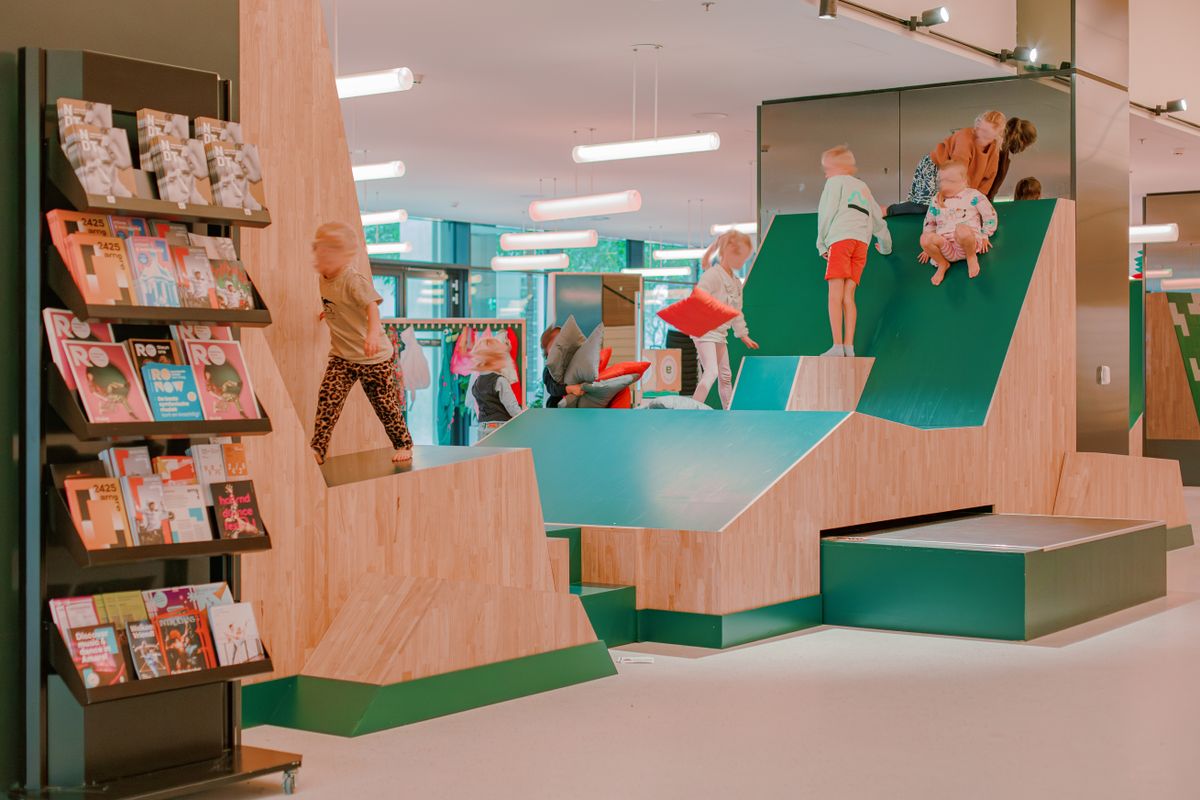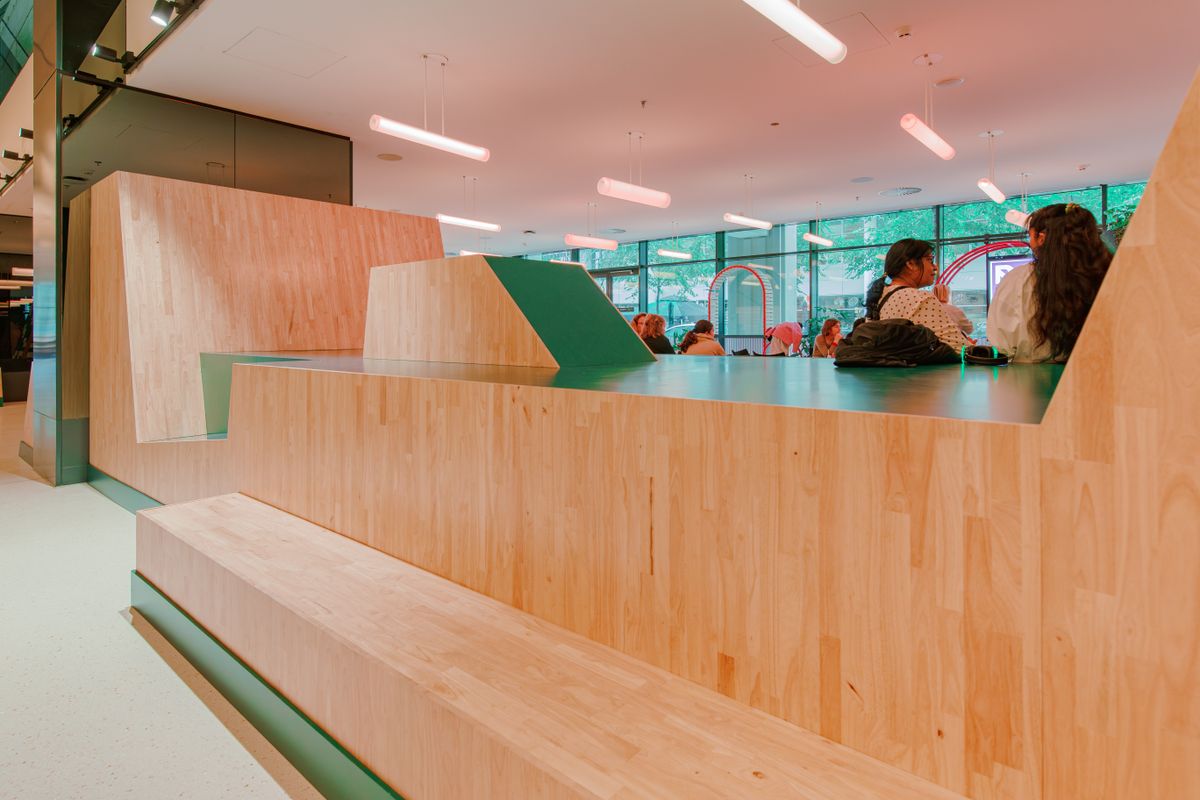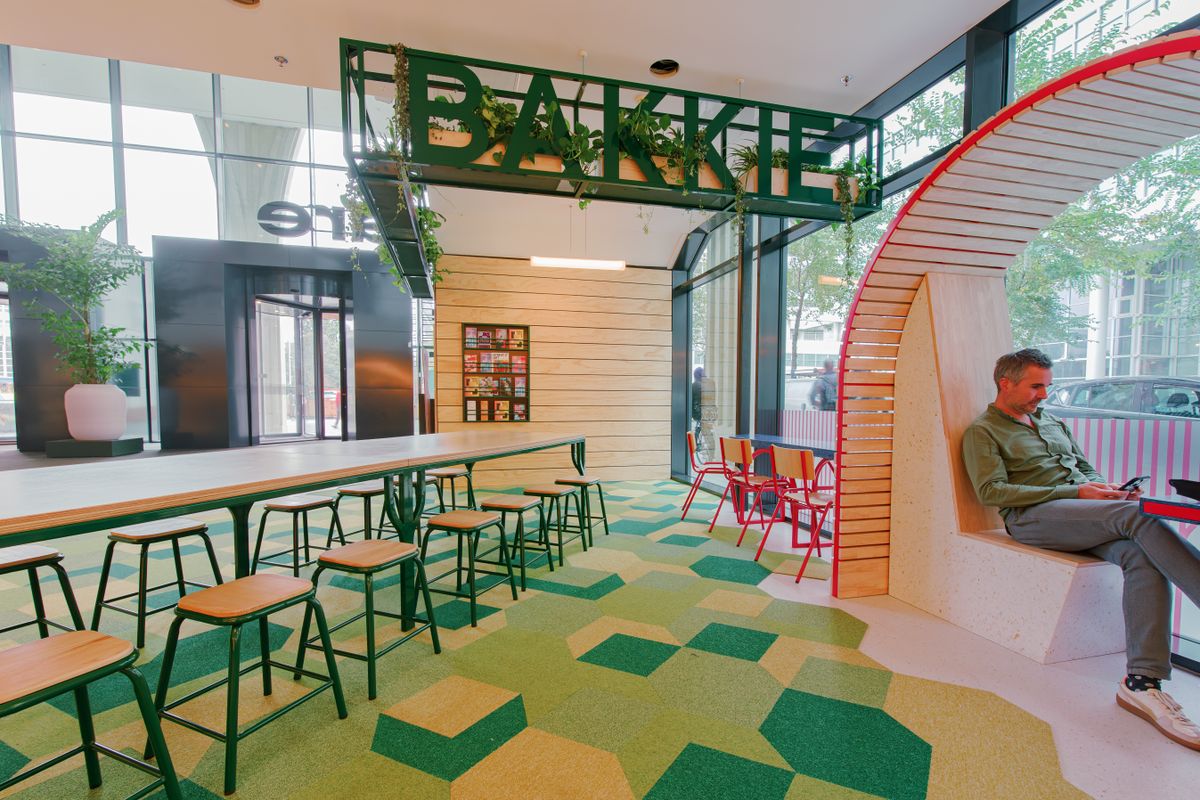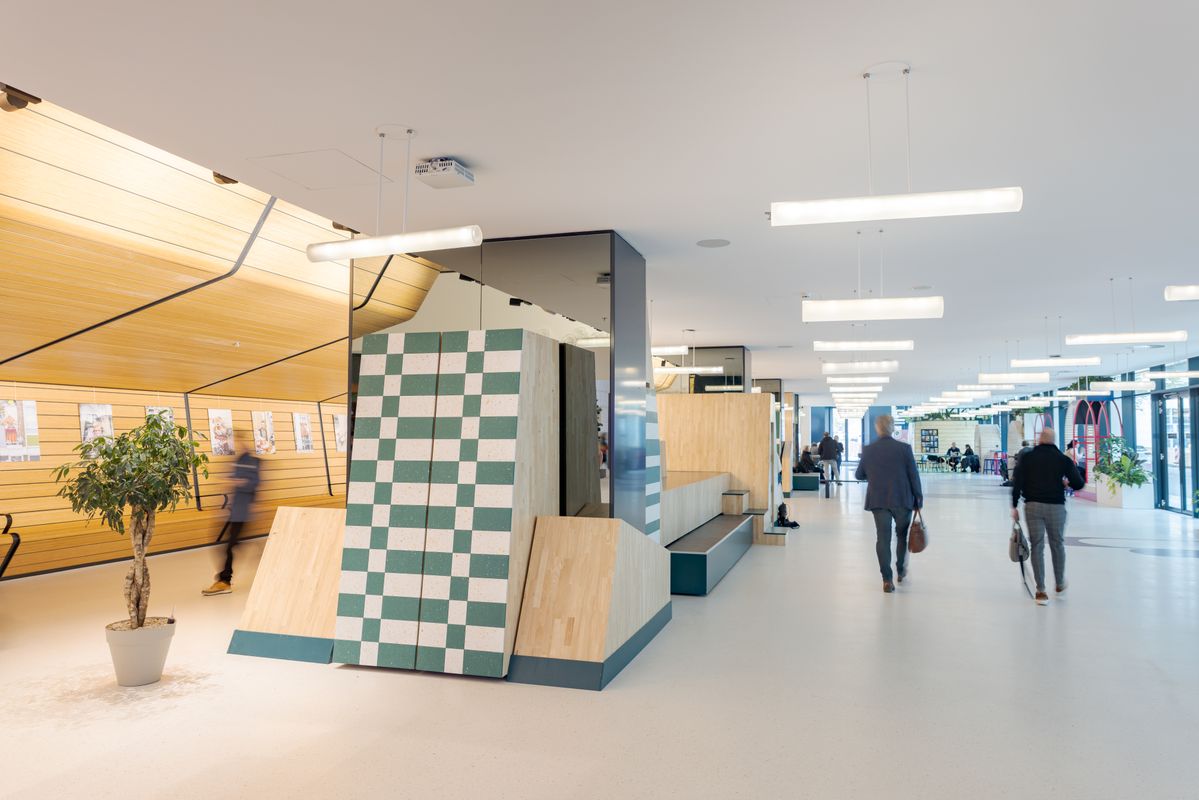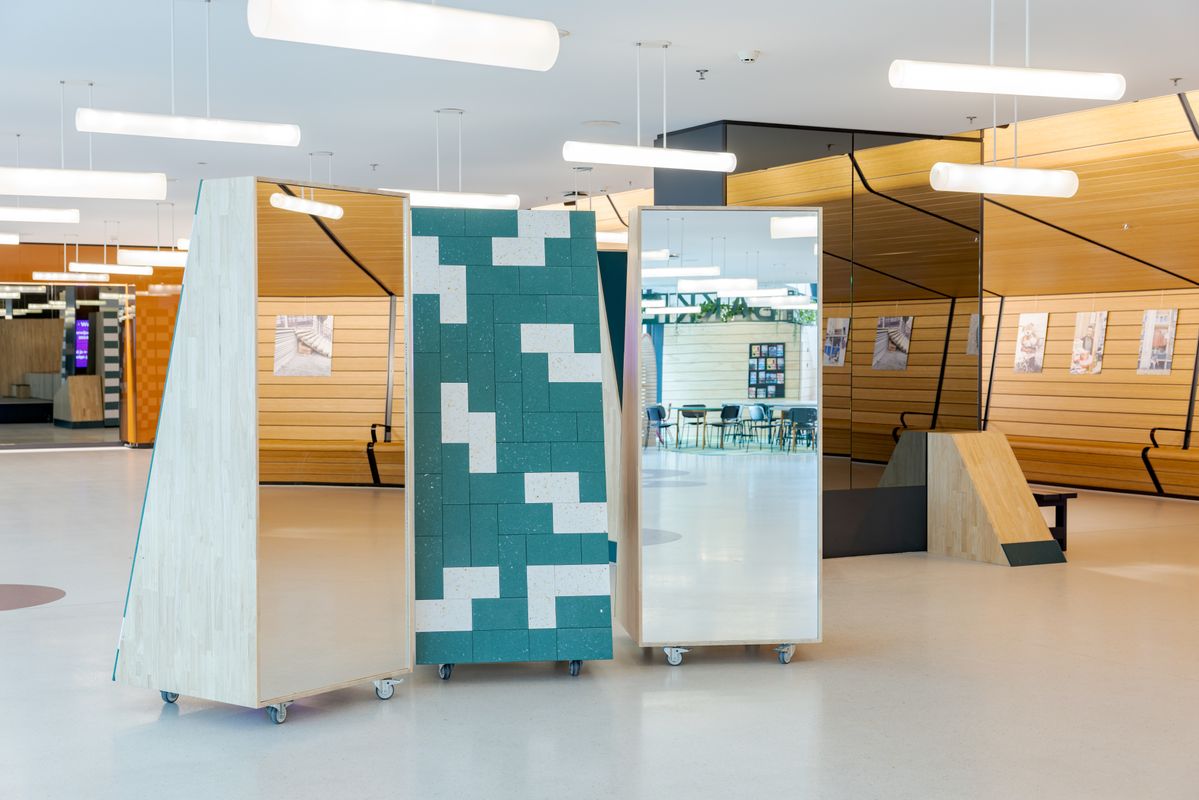
A look at the new furnishing of the Kunstenplein
5 December 2024, article
It won’t have escaped the attention of the regular visitor to Amare: our Kunstenplein, the public space on the ground floor, has been thoroughly revamped! Lots of cosy corners, playful elements, and plenty of space for the Open Amare activities. Come have a look!
There was quite a bit of sawing and sanding going on last summer, on Amare’s ground floor. The reason was that the Kunstenplein (or Arts Forum), the public and freely accessible space, was getting a thorough make-over. Among other things, additional work stations have been created as well as a large reading table where visitors can chat and enjoy a coffee.
The playful ‘rock walls’ that characterise the Tribune have become much more than just interior decoration: the space can now be arranged in multifunctional ways by means of various sliding elements. With an extendable stage, speakers, a mirror wall, a wardrobe and panels, much more can now be organised at Kunstenplein. This very much benefits Open Amare as well, the freely accessible programme in Amare’s public spaces.
Festival feeling
The furnishing has been designed and realised by Ontwerpbureau Triomf. Triomf has its roots in designing and building for festivals and other temporary venues, both indoor and outdoor. “Since we started in the festival scene, we feel very at home in cultural centres like TivoliVredenburg and Amare,” says Jasper Willemse, Managing Partner at Triomf. “In terms of dynamics, ambiance and use, these centres have a lot in common with festivals. In both cases, our goal is to contribute to the spaces of organisations that seek to have a positive impact on society.”
“Amare is an incredibly dynamic place where so much is happening all the time, both in front of and behind the scenes,” Jasper continues. “But because it’s so grand, some visitors might also feel a bit lost. Which is exactly why this job was truly cut out for us: how can we get visitors to feel at ease right away? How can we create places for visitors to land, so to speak? While the space also needs to be able to host a highly diverse programme.”
Playful elements
“We soon saw that the area could use some bright and colourful, playful elements,” explains Jasper. “We wanted to strike a light-hearted tone. The challenge in this project was to add this character by means of shapes, colours and materials, but without going over the top. It all had to blend harmoniously with the overall architecture.”
The choice to use sustainable and refreshing materials was important. That is why Triomf chose polygood as one of its materials. “Polygood is a recycled and recyclable plastic with bright colours, and in certain variants it resembles a tile. We also wanted to work with rubberwood, which is a residual product from rubber plantations.” Also for the corner carpet, Triomf used a tile made of 100% residual materials.
The team then started work on the design with around six people, and engaged various studios to help with the production. Everything came together in Triomf’s workplace in Utrecht last summer. All the materials were cut to size and then welded, glued, screwed, sandpapered and finished. The rock wall was so large that it had to be transported to Amare in parts and finished further on site.
Clambering on the rocks
Now that the renewed Kunstenplein is completely finished and functioning, Jasper is very pleased with the result. “You can’t really experience how an interior ‘lands’ in a space until it’s actually there. It breaks and fills the space, just the way we wanted it to. The colours and materials work well, visitors find their way very naturally, and the Tribune elements are frequently used.”
Gerko Telman, Open Amare’s creative director who spends time at Kunstenplein almost daily for the public programming, agrees. “We are already seeing how well the new set-up is used. People meet for a coffee at the Haags Bakkie terrace while their children clamber about on the rock wall, there’s dancing going on while other people drift in and relax on the furniture by the windows. The space is more playful and feels more sheltering. All sorts of elements have been added to the space, yet without getting in the way of functionality. There’s still plenty of room to dance, to work or just to hang out, and to make music and organise concerts.”
Amare as a free space
A large part of Amare is always open, says Gerko. "Seven days a week, from 07:30 to 23:00. Everyone is welcome to use the free space inside the building.” Open Amare activities are organised almost daily in the public spaces like Kunstenplein. The programme is freely accessible and varies from dance evenings to lectures, family days and singalong concerts. Especially for these programmes, the revamped interior adds a lot of value.
“A huge plus for Open Amare consists of all the functionalities incorporated in the new furnishing,” Gerko explains. “Things we often use have been built into the furniture, so we don’t need to keep fetching them from all sorts of storerooms on other floors in the building. We use the built-in wardrobe every day, and the rolling speakers are situated in a different spot every day. The green-white desk has been used for all sorts of purposes from the very start: sometimes it serves as a reception desk, on other days it’s a children’s bookcase.”
Own life
And so we gradually see the Kunstenplein environment take on a life of its own, exactly as intended. “Kunstenplein is a space that visitors are free to use as they like. Which always leads to surprises,” says Gerko. For instance, on the Family Sundays which are also a part of Open Amare, it turned out that small ‘niches’ naturally emerge in the rock wall when all the components have been rolled out. These were instantly and gratefully used by children to hide away in. “Right from the start we saw children crawling into these spaces with a cushion and a book,” Gerko smiles.
As Gerko comments, Kunstenplein is actually like a miniature society. Just like out there, in here we learn to treat each other respectfully and to live together peacefully. “Dialogue is very important to us, and part of that is listening to each other. We want Open Amare to be a place where people engage with each other in a positive way.”











